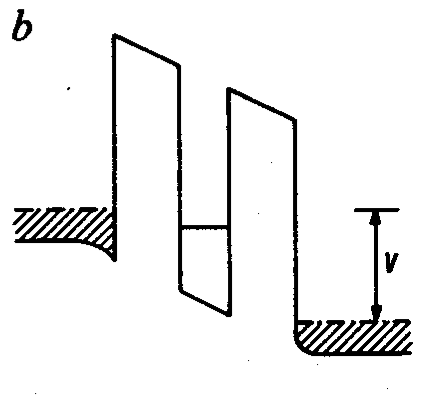This is something that I have been spending some time looking into over the past few hours, with luck the answer will be coherent. If something needs clarification, I will be happy to try my best.
edit: I just noticed that you are talking about point contact transistors. I'm not familiar with these devices, and so I don't know much about them. The following discusses tunnel diodes.
In quantum mechanics, the double barrier potential describes a system where there are two potential barriers to overcome for a particle to get through the system. This potential is a very simple picture what an electron will see in a resonant-tunneling diode:

Where \$E_F\$ is the fermi level of the semiconductor (see below), \$E_C\$ is the conduction band energy level (the lowest energy level occupied by electrons in the conduction band), and \$E_0\$ is the minum energy level band within the double barrier. The higher energy level bands within the double barrier can be labeled \$E_1\$ through \$E_n\$, and will be approximately quadratically space (\$E_n - E_{n-1} ∝ n^2\$). The conduction band will go from \$E_C\$ to \$E_F\$ (at zero temp).
Here, we need to talk about density of states. The figures shown are only for a single direction in space. For the other two directions, the momentum is less confined. The total momentum of an electron is:
$$
p_x^2 + p_y^2 + p_z^2 \leq 2mE_F
$$
For the energy band \$E_0\$, the momentum can be:
$$
p_x^2 + p_y^2 + p_z^2 \in 2mE_0
$$
There are two things that are necessary in order for the electron to tunnel: 1) the energy that it starts with, and the energy that it ends with must be the same. 2) the momentum in the \$z\$ direction that the electron starts with and ends with must be the same.

Initially as the bias voltage is applied, only electrons at the fermi level will be able to transition over. When this is the case, all the energy of the electron will be in the \$z\$ direction (\$p_x=p_y=0\$). As the bias voltage increases, more \$p_x\$ and \$p_y\$ states will be able to tunnel (\$p_z\$ will get smaller), hence increasing the current, hence a positive resistance (more voltage = more current). As the voltage bias continues to be increased, the energy of \$E_0\$, relative to the fermi level on the left \$E_F\$ decreases.
When \$E_0=E_C\$, only \$p_z=0\$ electrons can tunnel through, and for higher bias voltages than this, electrons must tunnel through both barriers in order to flow. However, with continued increase in the bias voltage, the higher energy levels of the double barrier potential \$E_1\$ will get close to \$E_F\$ allowing this process to continue (this time through \$E_1\$ rather than \$E_0\$). This leads to the positive differential resistance again.
This picture gets fuzzier at temperatures higher than 0 K. Lattice vibrations and temperature effects make this cutoff fuzzy, rather than sharp, leading to negative differential resistance.
Aside: The fermi energy can be though of in a couple of different ways, but for our purposes, I'm going to think about it this way: At zero temperature, this is the energy level of the highest occupied energy level of the solid. At non-zero temperature, there is some distribution of occupied energy levels above $E_F$ due to thermal energy being given to the electrons. This distribution decreases as you get to higher energy above the fermi energy. These electrons have to come from somewhere, so the energy levels occupied below the fermi level also decrease.
See: http://www.ece.sunysb.edu/~serge/67.pdf for a decent "review article" in Nature.




